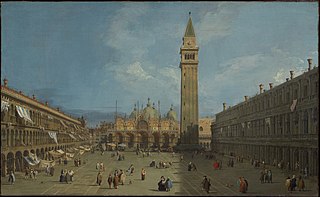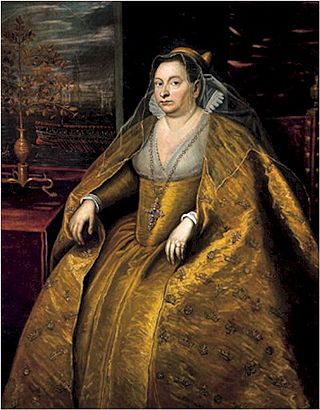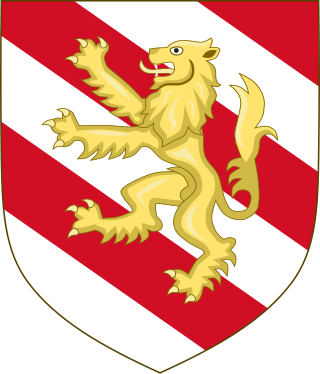
Year 1310 (MCCCX) was a common year starting on Thursday of the Julian calendar.

Piazza San Marco, often known in English as St Mark's Square, is the principal public square of Venice, Italy, where it is generally known just as la Piazza. Almost all the other urban spaces in the city are called campi ("fields"). The Piazzetta is an extension of the Piazza towards San Marco basin in its southeast corner. The two spaces together form the social, religious and political centre of Venice and are referred to together. This article relates to both of them.

Marino Faliero was the 55th Doge of Venice, appointed on 11 September 1354.

The Council of Ten, or simply the Ten, was from 1310 to 1797 one of the major governing bodies of the Republic of Venice. Elections took place annually and the Council of Ten had the power to impose punishments upon patricians. The Council of Ten had a broad jurisdictional mandate over matters of state security. The Council of Ten and the Full College constituted the inner circle of oligarchical patricians who effectively ruled the Republic of Venice.

Pietro I Orseolo OSBCam, also named Peter Urseulus, (928–987) was the Doge of Venice from 976 until 978. He abdicated his office and left in the middle of the night to become a monk. He later entered the order of the Camaldolese Hermits of Mount Corona. He is venerated as a saint in the Catholic Church. In 1733 the Venetian librarian Giuseppe Bettinelli published an edition of a biography written by the Friar Fulgenzio Manfredi in 1606.

Jacopo Tiepolo, also known as Giacomo Tiepolo, was Doge of Venice from 1229 to 1249. He had previously served as the first Venetian Duke of Crete, and two terms as Podestà of Constantinople, twice as governor of Treviso, and three times as ambassador to the Holy See.

Pietro Gradenigo was the 49th Doge of Venice, reigning from 1289 to his death.

Dogaressa was the official title of the wife of the Doge of Venice. The title was unique for Venice: while the head of the Republic of Genoa were also called Doge, the wives of the Doges of Genoa were not called Dogaressa, nor did they have such a public position.

Giovanni Soranzo was a Venetian statesman of the prominent Soranzo family who served as the 51st Doge of Venice. He ascended to the position on 13 July 1312 and served until his death. Soranzo was a member of a noble family; he was married to Franchesina. In 1310 his son-in-law, Niccolo' Querini was exiled for life from Venice for taking part in Bajamonte Tiepolo's conspiracy to overthrow the state. Soranzo was succeeded as Doge by Francesco Dandolo.
This article presents a detailed timeline of the history of the Republic of Venice from its legendary foundation to its collapse under the efforts of Napoleon.
The Great Council Lockout refers to the constitutional process, started with the 1297 Ordinance, by means of which membership of the Great Council of Venice became an hereditary title. Since it was the Great Council that had the right to elect the Doge, the 1297 Ordinance marked a relevant change in the constitution of the Republic. This resulted in the exclusion of minor aristocrats and plebeian from participating in the government of the Republic. Although formerly provisional, the Ordinance later became a permanent Act, and since then it was disregarded only at times of political or financial crisis.

The Diocese of Castello, originally the Diocese of Olivolo, is a former Roman Catholic diocese that was based on the city of Venice in Italy. It was established in 774, covering the islands that are now occupied by Venice. Throughout its existence there was tension between the diocese, the Patriarchate of Grado to which it was nominally subordinate, and the Doge of Venice. Eventually in 1451 the diocese and the patriarchate were merged to form the Archdiocese of Venice.

Andrea Ghisi was a Venetian nobleman, and the first Lord of Tinos and Mykonos.

Gentlemen of the Night is a 1964 Italian-French adventure film directed by Pino Mercanti and starring Guy Madison and Lisa Gastoni.
Geremia Ghisi was a Venetian nobleman who in ca. 1207, following the Fourth Crusade, captured the Greek islands of Skiathos, Skopelos, and Skyros and became their lord, while his brother Andrea Ghisi conquered the islands of Tinos and Mykonos. Their sister or half-sister, Agnese Ghisi, married Othon de Cicon, who became the lord of Karystos on Euboea.
Andrea Cappello was a Venetian nobleman, merchant, banker, and politician. He is the inventor of the press.

The Provveditore Generale da Mar was the most senior peacetime office in the Venetian navy and in charge of governing the Venetian overseas empire.
The Podestà of Constantinople was the official in charge of Venetian possessions in the Latin Empire and the Venetian quarter of Constantinople during the 13th century. Nominally a vassal to the Latin Emperor, the Podestà functioned as a ruler in his own right, and answered to the Doge of Venice. The podestà was also officially known as Governor of One-Fourth and One-Half of the Empire of Romania and was entitled to wearing the crimson buskins as the emperors.

The Venetian patriciate was one of the three social bodies into which the society of the Republic of Venice was divided, together with citizens and foreigners. Patrizio was the noble title of the members of the aristocracy ruling the city of Venice and the Republic. The title was abbreviated, in front of the name, by the initials N.H., together with the feminine variant N.D.. Holding the title of a Venetian patrician was a great honour and many European kings and princes, as well as foreign noble families, are known to have asked for and obtained the prestigious title.

The Badoer were an aristocratic family in the Republic of Venice. The Badoer traced their ancestry, without any factual basis, to Doge Giustiniano Participazio in the early 9th century. In fact, they rose to prominence in the 13th century.












